








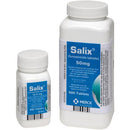
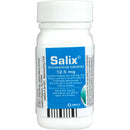
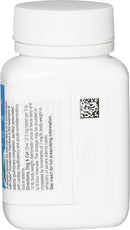
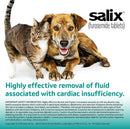
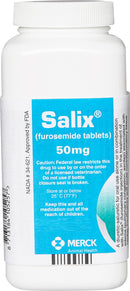
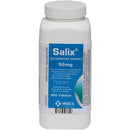
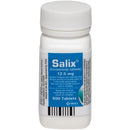
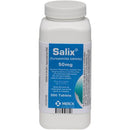

What is Furosemide (Salix)?
Furosemide is a diuretic used to treat fluid retention (edema) in dogs, cats, and horses with congestive heart failure, liver disease, or certain kidney disease. Furosemide is also used to treat high blood pressure. Furosemide for dogs and cats is sold as a 10 mg/ml 60 ml bottle oral solution or by the tablet and sold for dogs, cats, and horses as a 50 mg/ml injectable solution. Furosemide for cats, dogs, and horses requires a prescription from your veterinarian.
For:
Cats, Dogs, and Horses
Benefits:
- Treats excessive fluid accumulation and swelling caused by heart failure and other health problems
- Easy to administer
- Sold as 10 mg/ml 60 ml bottle oral solution or by the tablet for dogs and cats and as a 50 mg/ml injectable solution for horses, cats, and dogs
How does Furosemide (Salix) work?
Furosemide is a potent diuretic which works by blocking the absorption of salt and fluid in the kidney tubules causing an increase in urine output.
Cautions:
Keep plenty of water available for your pet or horse to drink. Furosemide can make your pet's or horse's skin sensitive to sunlight. There are possible adverse interactions with other drugs, so fully disclose to your veterinarian what you are giving your pet or horse. This medication should not be used in pregnant or nursing animals.
Brand Name:
Lasix (Aventis), Salix (Merck)
Generic Name:
Furosemide (Vedco)
What is the most important thing I should know about Furosemide (Salix)?
Do not give this medication if your pet or horse is not urinating. Tell your veterinarian if your pet or horse has kidney or liver disease, diabetes, or an allergy to sulfa drugs. Furosemide can make your pet's or horse's skin more sensitive to sunlight and sunburn may occur. Periodic blood tests, as well as kidney or liver function tests, may be necessary. Furosemide will make your pet or horse urinate more often. Your pet or horse should have drinking water readily available to prevent dehydration and electrolyte imbalance. Furosemide is a loop diuretic (water pill) used to treat fluid retention (edema) in dogs, cats, and horses with congestive heart failure, liver disease, or certain kidney disease. Furosemide is also used to treat high blood pressure. Furosemide is available by prescription as Furosemide Oral Solution containing 10 mg/ml, and in 12.5 mg (round yellow), 20 mg (round white), 40 mg (round white), 50 mg (round yellow), and 80 mg (round white) tablets for cats and dogs. It is also available by prescription as a 50 mg/ml injectable solution for cats, dogs, and horses. The usual dose of furosemide in dogs and cats is 1-2 mg/pound once or twice a day (at 6 to 8 hour intervals). Cats will usually get the lower dose. The usual dose for horses is 5-10 ml once or twice daily (at 6 to 8 hour intervals). Higher doses can be given depending on the severity of symptoms. Discard the opened bottle of Oral Solution after 90 days. Furosemide may also be used for purposes other than those listed here. The injectable solution does not include a syringe.
What should I discuss with my veterinarian before giving Furosemide (Salix) to my pet or horse?
Do not give this medication if your pet or horse is not urinating. Tell your veterinarian if your pet or horse has kidney or liver disease, diabetes, or an allergy to sulfa drugs. Tell your veterinarian if your pet or horse is pregnant or lactating.
How should Furosemide (Salix) be given?
Give this medication exactly as directed by your veterinarian. Do not give larger amounts, or give it for longer than recommended by your veterinarian. Your veterinarian may occasionally change the dose to make sure your pet or horse gets the best results from this medication. Furosemide will make your pet or horse urinate more often, so your pet or horse should have drinking water readily available to prevent dehydration and electrolyte imbalance. Periodic blood tests as well as kidney or liver function tests may be necessary. Store this medication at room temperature away from heat, light, and moisture. The injectable solution can be administered by intravenous (IV) or intramuscular (IM) injection.
What are the potential side effects of Furosemide (Salix)?
If any of the following serious side effects occur, stop giving furosemide and seek emergency veterinary medical attention; an allergic reaction (hives, difficulty breathing, swelling of the face, lips, tongue, or throat). Stop giving furosemide and call your veterinarian at once if any of these serious side effects occur; dry mouth, thirst, nausea and vomiting, weakness, drowsiness, restlessness, irregular heartbeat, muscle pain or weakness, urinating less than usual or not at all, bleeding, unusual weakness, hair loss, "bulls-eye" lesions, vesicles around mouth, ears, and groin; hearing loss, nausea, stomach pain, fever, loss of appetite, dark urine, or jaundice. Continue giving furosemide and talk with your veterinarian if any of these less serious side effects should occur: diarrhea, constipation, or stomach pain, headache, dizziness, or blurred vision. Side effects other than those listed in this guide may also occur. Talk to your veterinarian about any side effect that seems unusual or especially bothersome to your pet or horse.
What happens if I miss giving a dose of Furosemide (Salix)?
Furosemide is sometimes used only once, so that there may not be a dosing schedule. If you are giving furosemide regularly, give the missed dose as soon as you remember. However, if it is almost time for the next dose, skip the missed dose and wait until the next regularly scheduled dose. Do not give a double dose of the medication.
What happens if I overdose my pet or horse on Furosemide (Salix)?
Seek emergency veterinary medical attention if you believe you have given your pet or horse too much medication. Symptoms of furosemide overdose may include loss of appetite, weakness, dizziness, confusion, fainting.
What should I avoid while giving furosemide?
Avoid allowing your pet or horse to become dehydrated. Keep plenty of water available for your pet or horse to drink. Furosemide can make your pet's or horse's skin more sensitive to sunlight and sunburn may occur.
What other drugs will affect Furosemide (Salix)?
If you give your pet or horse sucralfate (Carafate), give it at least 2 hours before or after giving furosemide. Tell your veterinarian if your pet or horse is being given digoxin (Lanoxin), steroids (such as prednisone), other blood pressure medications, Amikacin, gentamicin, tobramycin, salicylates such as aspirin (Vetrin), or indomethacin. Drugs other than those listed may also interact with furosemide. Tell your veterinarian about all the prescription and over the counter medications you are giving your pet or horse. This includes vitamins, minerals, and herbal products.
How to Use
Furosemide (Salix) Directions:
- Furosemide is a loop diuretic available by prescription used to treat fluid retention (edema) in dogs, cats, and horses with congestive heart failure, liver disease, or certain kidney disease. Furosemide is also used to treat high blood pressure.
- Do not give this medication if your pet or horse is not urinating.
- Furosemide can make your pet or horse's skin more sensitive to sunlight and sunburn may occur.
- Discard the open bottle of Oral Solution after 90 days.
- The injectable solution can be administered by IV or IM injection.
